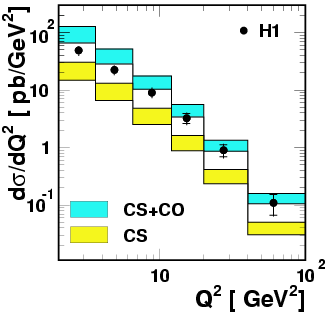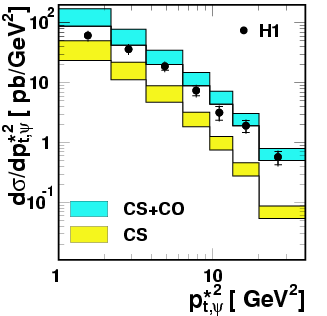  |
|
|
We know from many measurements that protons consist of quarks - three 'light' valence quarks and a sea of quark-antiquark pairs. The quarks hold together by a continous exchange of gluons. These gluons are the carriers of the strong force and carry the 'charge' of the strong force, called colour. So protons contain not only quarks but also gluons.
'Heavy' quarks, like the charm quark c, can be produced in
electron proton scatterings at HERA by the process of photon gluon
fusion: Here a gluon out of the proton splits into
a charm/anti-charm pair that reacts with a photon emitted by the
incoming electron.
After this production process the heavy
charm/anti-charm pair can transform into a bound state, the J/psi
meson, which we observe in the detector.
Gluons carry colour, and when the charm/anti-charm pair
is produced it keeps this colour, it is in a colour octet state.
Now, observable free particles are colourless, i.e. in colour singlet states
as predicted in the theory of the strong force, Quantum
Chromo-Dynamics QCD, and as verified by experiments.
Thus, also the J/psi meson is expected to be colourless.
For this reason there must be some mechanism in
the production of the bound charm/anticharm state, to get rid of the
colour.
Several theoretical approaches exist to describe J/psi production. Here only two are explained in more detail:
In the following figure on the left hand side the data are compared
with the calculations as a function of the
photon virtuality Q2.
The yellow band of the CS prediction falls below the data by a factor of
three. On the other hand the full NRQCD
calculation (blue band), containing both colour singlet and colour octet
contributions (therefore labeled with CS+CO) is in agreement with the
data in normalisation and shape at high values of Q2.
On the right hand side the squared transverse momentum
pt*2 of the J/psi
meson calculated in the photon-proton system for
Q2 > 2 GeV2 is shown. Again we see,
that the CS+CO calculation describes the shape of the data well at
large values of
pt*2 while the CS model tends to predict a dependence
which is too steep.
|
  |
|
This pattern, that better agreement between data and theory is found at larger
values of
Q2 or pt*2 is quite interesting because in
this region the theory is more reliable and
theoretical uncertainties decrease.
On the other hand the experimental results show larger
uncertainties here due to lower statistics.
A study on inelastic J/psi production in the range of
photoproduction (this means we have a quasi-real photon emitted from
the electron - Q2=0) can be found
here.
|
|
|